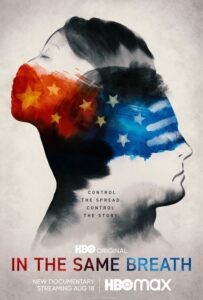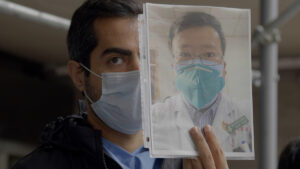Interview with “In the Same Breath” Director Nanfu Wang
Written by: Hannah Tran | August 23rd, 2021

I recently had the immense pleasure of talking to Nanfu Wang, a director who seems completely without fear as she takes on films directly about highly controversial subjects, such as 2016’s Hooligan Sparrow and 2019’s One Child Nation. Her latest film, In the Same Breath (which I reviewed out of Sundance), is no different. Sometimes it might even make you question how you’re allowed to watch it at all. Following the outbreak of COVID-19 and the official responses to it over the course of one year, Wang aims to expose the failings and hypocrisy of authoritarian systems from the inside out. With each of her films, Wang’s scope has grown larger in scale, but her nuanced and daring focus feels sharper than ever.

In just over 90 minutes, In the Same Breath never lets your attention go. From beginning to end, each look into the inside of the crisis feels as if it only exists through some miraculous inspiration or pure luck. Every moment holds the power to access real feelings of heartbreak, loss, and anger experienced by the public in response. And most of all, each moment holds the power to force you to question the stories we are told by those who tell them.
Hannah Tran: As humans, it can be so difficult to detach from our identities and experiences. As a documentarian who was born in China and now lives in New York, how do you feel about the idea of bias in your work? Do you feel that going in with biases helps you or do you try to eliminate them?
Nanfu Wang: Each one of us has biases, not only because we are Asian or live in the U.S. as Asians. People in the U.S., people in China, people in England, and in any country, have biases. I certainly do. Oftentimes, I would realize my bias during the making of this film. They came from research I did or something someone had told me, and I would then discover something that was different than my preconceived notions. I embraced that. I corrected myself, and I think sometimes it’s in the film and you can see it, and sometimes it’s behind the camera, and you can’t see it.
HT: Because there’s such a wide scope and you couldn’t physically shoot all these stories yourself, I was wondering if you could talk about how you worked with the different cinematographers and chose a visual approach.
NW: The visual approach is instinct. I ask myself if I imagine it as handheld or tripod. Then, I give references to how to do it. Part is instinct, and for a lot of the footage from the ambulance and hospital there was a vérité approach. I told them to film nonstop, meaning you can’t put it down, and you can’t be on the tripod because you’re moving constantly. A lot of it was shot on gimbals.
I would say consistency was a main priority, so there was a lot of trial and error. Like the sequence with the window, for example. I would get something, and it wouldn’t be how I imagined because the drones would fly too fast or there would be quick movements, and I would be like, “No, it has to be slow as if it just stays there.” And some people would come back with footage that had a glorious feel, like a “look at our city” type feel, so I would have to tell them to go back again for a second or third time until it was right.
HT: So you originally intended this film to be a short. I was wondering how it evolved over time and when you felt you had found your thesis.
NW: I would say I found it in May. In March, I had a lot of questions, and in April, I was searching for answers. When I started the film in January or February, I knew what scenes would expose what the Chinese government did wrong and show people the reality of what was happening in China, so that core theme was clear to me. Then in March, it started to hit the U.S., and that was when I started confronting my own biases. My bias was that what happened in China would never happen in the U.S. What happened in China was due to an authoritarian government. They have strict censorship and spread propaganda, and there is no free flow of information or transparency. The U.S. is a self-proclaimed democratic country with free access to information and freedom of speech, so why were mistakes still made?

By May, what you saw in the film with the healthcare workers is that, just like in China, they tried to sound the alarm and were silenced. Some of them were even fired from their job. And much like the Chinese government officials, the CDC told these people that there was no reason to worry, that there was no risk, that there was no threat. I started to see the same pattern emerge, and it was very eerie. It made me realize that misinformation exists anywhere and can be more dangerous in democratic countries because people think they’re immune to it, much like they are immune to COVID. In a democratic country, everyone believes they are the holder of the truth which creates a bigger problem because they can’t see it in any other way, so that became the main theme of the film.
HT: One moment that really fascinated me is when you’re at the COVID protest by Trump supporters. Where I think many other filmmakers would immediately write them off or mock them, you actually make an attempt to understand them and empathize with them. In a time with so much derision, how do you think we can be more empathetic?
NW: I think empathy is not learned. Maybe I’m wrong, but in my experience it’s not. Before seeing those people I never had a chance to talk to them. When I did, I realized how similar every human being is in the sense of wanting to have transparency and accurate information. They may express it in a different way, but the people they trust and the information they consider to be truth is different. To me, empathy comes from the realization that those people consume a different narrative than I do, and there is a huge difference between the creators of a narrative and the consumers of a narrative.
Like, I would never blame those in the film who say the government did a good job in China because I know how they became who they are and what kind of life they lived. I love each one of them. I don’t see them as different from me just because they say things I disagree with. That’s a result of decades of consumption of different information, and their ideology is formed from that. So when I do see the Trump supporters at the protest, I recognize the same issue and question the source of their beliefs. They didn’t invent the theories. They didn’t create the idea that Asians created the coronavirus. It comes from somewhere, and we should examine where from and how it became so convincing to them.

HT: That was just one fascinating moment in the film with so many. What was it like choosing what to include in the film from all of these horrifying and heartbreaking stories, and were there many you had to leave out?
NW: There are a ton. There were hundreds of patients in China who posted on social media about their medical records and situation. We called hundreds of them and filmed many of them, too. Each one has a devastating story to tell about their loss, but it’s impossible to fit all of those stories in a 90-minute film, so I struggled and tried to put in as many as I could. Each one of them was basically edited into a short film, and when you put them all together, there is not enough time. And when you hear one and another and another, the later ones become less powerful. You don’t have the time to really be with them and to meet them in the way I experienced, so that was my frustration and my sadness.
I wish I could show each one of their stories, but I couldn’t. I hope people can listen to those stories, because people who don’t have experience with loss and can’t meet those people or experience don’t really know what it’s like. When I was interviewing people, I would cry during one story and then jump on another and cry. But if you don’t hear that, they are just numbers and names.
HT: I think the audience feels that weight and your heartbreak. One scene my mind keeps coming back to is that long take of the two healthcare workers walking through the streets with a stretcher. It’s so powerful.
NW: Yes, and it’s so hard for me to edit that down. That scene is one shot, from them getting out to them loading the patient into the ambulance. And it’s just that walk, and then it starts raining. It was 15 minutes long, and I sat there and watched it and cried. I just wish I could put those whole 15 minutes in the movie, but I can’t because then it’s not consistent with the style, and you take time away from other stuff. So I had to cut it to 30 seconds.

HT: It feels so much longer than that, and I think you do a great job at representing those untold minutes and untold stories in the ones you do choose. Anyways, thank you so much for speaking with me. It was a pleasure!
NW: Yes, thank you. It was great talking with you.
[In the Same Breath was released on HBO Max on August 18.]

